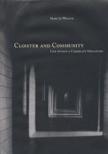Out of This World
This book blends several stories into a rich tapestry. The governing story is that of the Carmelite community in Indianapolis, from its beginnings in 1922, when three sisters made of a small house in New Albany their temporary quarters for a new foundation, to the permanent monastery in Indianapolis that would be consecrated in 1932 and undergo architectural additions and changes until 1988. Mary Jo Weaver, a professor of religious studies at Indiana University, weaves the story of this contemplative order into the larger history of Christian spirituality, as well as the history of the Carmelite order, with major emphasis on the work and teachings of St. Teresa of Avila. The story moves ahead into the 20th century and Vatican II Catholicism as the author gathers the strands of a reforming spirit that would alter the face of Carmelite spirituality, encouraging the nuns to explore the cosmic dimension of contemplation beyond enclosure.
Cloister and Community is structured according to the number six. Just as there were six stages in the building and modification of the monastery, so the book has six chapters. These cover not only the changes and additions to the monastery over time but also explain their importance in terms of six spiritual concepts: sacred space, principles of Teresian reform, poverty, enclosure and silence, prayer and mystical union and a new spiritual consciousness (largely inspired by Pierre Teilhard de Chardin).
Chapter Five, entitled Moving Stillness, exemplifies this correspondence of architectural and spiritual concepts. Weaver considers the role of prayer and mystical union in the Christian tradition, then focuses on St. Teresa’s experiences and teachings on prayer; and finally, she illustrates how the Carmelite community in Indianapolis sought to enrich its prayer life in the spirit of the Second Vatican Coucil with two major architectural changes. The first was to build a chapel and a new choir, the latter open to lay people, whose participation in the liturgy the sisters were encouraging. The second change was to build hermitages within the monastery, where the sisters individually might experience deeper solitude and prayer.
Weaver’s tapestry intertwines the historical strands of Christian spirituality and the Teresian reform of the Carmelite order with that of the monastery’s architectural history and the spiritual significance of the additions and modifications to its structure. The book will be attractive to lay people and religious in quest of both tradition and creativity in their own spiritual quest and, in addition to the present-day Indianapolis Carmel, to the larger Carmelite community that wishes to preserve its history while also responding to the needs of a changing world.
This is a well-written and fascinating portrait of a cloistered community of women, told with knowledge and loving care.
This article also appeared in print, under the headline “Out of This World,” in the October 14, 2002, issue.








